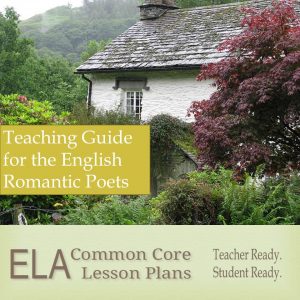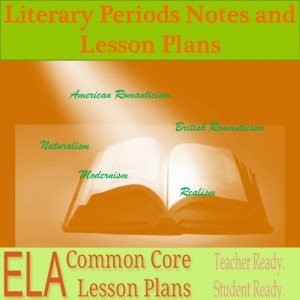British Romanticism and the English Romantic Poets
British Romanticism does not refer to Mick Jagger making out with a bimbo. It refers to a literary movement in England that took place roughly between 1785-1830. Romantic Poets include Keats, Shelley, Wordsworth, Coleridge, Blake, and Byron.
If you like this page, you’ll love this downloadable/printable pdf that takes these notes on British Romanticism, American Romanticism, naturalism, Realism and Modernism and puts them each on a 1-page handout, easily distributed to your class. There’s also lesson plans with graphic organizers that you can print out and place in your lesson plan book. It’s only $3.50. Buy it. It’s awesome. Find more at Teacher Guide Central.
ELA Common Core Standards Covered
Teaching British Romanticism and the English Romantic Poets covers the following ELA Common Core Standards.
- RL.9-10.1 Cite strong and thorough textual evidence to support analysis of what the text says explicitly as well as inferences drawn from the text.
- RL.9-10.2 Determine a theme or central idea of a text and analyze in detail its development over the course of the text, including how it emerges and is shaped and refined by specific details; provide an objective summary of the text.
- RL.9-10.4 Determine the meaning of words and phrases as they are used in the text, including figurative and connotative meanings; analyze the cumulative impact of specific word choices on meaning and tone (e.g., how the language evokes a sense of time and place; how it sets a formal or informal tone).
- RL.9-10.5 Analyze how an author’s choices concerning how to structure a text, order events within it (e.g., parallel plots), and manipulate time (e.g., pacing, flashbacks) create such effects as mystery, tension, or surprise.
Characteristics of Romantic Poets
Beauty of the Supernatural: British Romantics believed something existed beyond the physical world. The Spirit world, according to Romantics, had unleashed its power and inspiration to overthrow tyranny in government and in literature. Unlike the American Romantics who wrote of ghosts, demonic cats, and rope-gnawing rats, British Romanticism’s treatment of the supernatural excluded horror and the macabre and focused on supernatural energy and beauty.
Championing of the Individual: Revolution in Europe brought to light the importance of the individual. Ordinary people now became the subject of lofty language. British Romanticism attempted to free itself from traditional forms and subjects.
The Importance of Nature: The poet, according to the Romantics, is only at peace when in nature; moreover, while in nature, the poet intervened with the great Universal Mind. Romantic poets made frequent use of personification with nature, ascribing human traits to daffodils, fields, streams, and lakes. Nature, in essence, became emotionally expressive.
The Dangers of Technology: A natural consequence of celebrating nature was a disdain for technology and industrialism.
Major Early Romantic Poets

William Wordsworth (1770-1850): The most famous of the British Romantics, Wordsworth is considered the nature poet. He revolutionized poetic subjects, focusing on ordinary people in rustic settings. He, in addition, wrote about and considered the poet as superior to all other writers. His most famous poems include I Wandered Lonely as a Cloud, We are Seven, and I Travelled Among Unknown Men. Most high school literature textbooks have at least one poem by Wordsworth.
Samuel Taylor Coleridge (1772-1834): Coleridge and Wordsworth are often grouped together as The Lake Poets, and for good reason. Together they are credited as the founders of the Romantic movement. Coleridge’s most famous poems, Rime of the Ancient Mariner, Kubla Kahn, and Christabel have a distinct supernatural element and strongly influenced American Romantics such as Poe and Hawthorne.
Later Romantic Poets
Lord Byron (1788-1824): Lord Byron enjoyed unmatched popularity. Byron’s most famous creations are his dark heroes, called Byronic heroes, who, in fact, were not heroes at all, but stood out from ordinary humans as larger than life. The Byronic hero brooded, possessed insatiable appetites and incredible strength, rebelled against societal norms, and forced upon himself exile. Byron’s most famous works include Don Juan and Childe Harold’s Pilgrimage. Lord Byron is generally reserved for university level literature courses and is rarely found in high school anthologies.
Percy Bysshe Shelley (1792-1822): Like all Romantics, Shelley was a radical non-conformist. He campaigned for social justice, even marrying the daughter of Mary Wollstonecraft, an English leader in the women’s rights movement. His wife would later write Frankenstein. His most famous poems include Mutability, Ozymandias, and Ode to the West Wind.
John Keats (1795-1821): Perhaps the most popular Later Romantic poet, Keats accomplished great things during his short life. His Ode to a Nightingale, Ode on a Grecian Urn, and Ode on Melancholy find their way into anthologies throughout the English speaking world. Keats considered contact with poets as a threat to his independence and therefore shunned his contemporaries.
Want more? Try annotating a poem for practice.
Genres of Literature
Teaching literary genres helps provide context and understanding.
Share This: